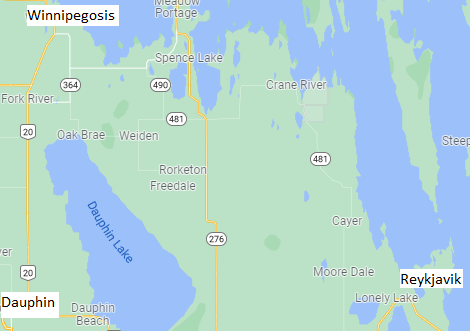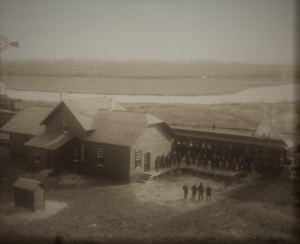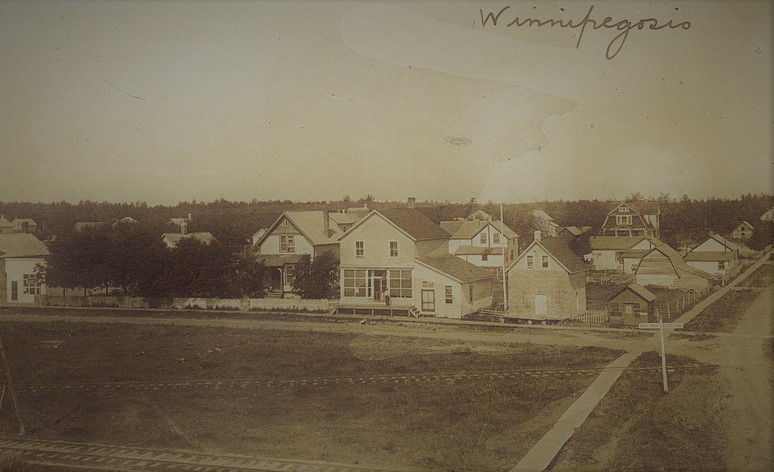
Fort Dauphin is today a protected historical site, a museum in Manitoba. Photo: MHS
 The name Winnipegosis is a word from the indigenous Cree language and means little muddy water and is therefore closely related to Winnipeg, muddy water. The village is about 380 km (236 miles) from Winnipeg and 170 km (105 miles) northwest of Reykjavik, which is the northernmost Icelandic community by Lake Manitoba. The Mossey River flows from Lake Dauphin north into Lake Winnipeg. The village was built on the west side of the river where it flows into the lake. French explorers surveyed the areas between the Great Lakes of Manitoba and the areas west of Lake Manitoba, with Pierre Gaultier de Varennes leading the way. It was his son who built Fort Dauphin in 1741 near what is now Winnipegosis. Later, Hudson’s Bay Co. built a trading post nearby. In the first half of the 19th century, the fur trade flourished and around the fortresses, immigrants settled lands and small communities were formed. The skins were transported by rivers and lakes to Lake Manitoba and by steamboat south on the lake, and finally wagons pulled by oxen or horses to Winnipeg. With a large increase in rail traffic in southern Manitoba from 1880 to 1890, settlement in areas north and west of Lake Manitoba expanded. The need for a railway was great and around 1890 work began on a railway north along Lake Manitoba to Dauphin and finally from there in 1896 to Winnipegosis. That year, two hotels and two guesthouses had been built in the village, three shops provided the villagers and the inhabitants of the surrounding countryside with necessities. Butchers and blacksmiths did their work in the appropriate shops; where a sawmill was was erected and two large fishing companies had bases there. There was a lot of employment related to fishing and logging, it attracted immigrants, Icelanders among them.
The name Winnipegosis is a word from the indigenous Cree language and means little muddy water and is therefore closely related to Winnipeg, muddy water. The village is about 380 km (236 miles) from Winnipeg and 170 km (105 miles) northwest of Reykjavik, which is the northernmost Icelandic community by Lake Manitoba. The Mossey River flows from Lake Dauphin north into Lake Winnipeg. The village was built on the west side of the river where it flows into the lake. French explorers surveyed the areas between the Great Lakes of Manitoba and the areas west of Lake Manitoba, with Pierre Gaultier de Varennes leading the way. It was his son who built Fort Dauphin in 1741 near what is now Winnipegosis. Later, Hudson’s Bay Co. built a trading post nearby. In the first half of the 19th century, the fur trade flourished and around the fortresses, immigrants settled lands and small communities were formed. The skins were transported by rivers and lakes to Lake Manitoba and by steamboat south on the lake, and finally wagons pulled by oxen or horses to Winnipeg. With a large increase in rail traffic in southern Manitoba from 1880 to 1890, settlement in areas north and west of Lake Manitoba expanded. The need for a railway was great and around 1890 work began on a railway north along Lake Manitoba to Dauphin and finally from there in 1896 to Winnipegosis. That year, two hotels and two guesthouses had been built in the village, three shops provided the villagers and the inhabitants of the surrounding countryside with necessities. Butchers and blacksmiths did their work in the appropriate shops; where a sawmill was was erected and two large fishing companies had bases there. There was a lot of employment related to fishing and logging, it attracted immigrants, Icelanders among them.

Winnipegos Railway Station in 1897. Photo: MHS
Icelanders in Winnipegosis
According to Vesturfaraskrá of Júníus H. Kristinsson 1st Table, about 6000 Icelanders moved to the West in the years 1886-1894, most of them to Canada and west on the plains. Among them was Finnbogi Hjálmarsson from Breiðuvík in Tjörnes in S. Þingeyjarsýsla. He came to Winnipeg with his wife, Ólöf Ólafsdóttir, and their only child in 1887. They settled in N. Dakota, where they remained until 1899. Then they moved to Winnipeg, where they lived thereafter. Finnbogi wrote Settlement Episodes from the Icelanders in Winnipegosis which were published in the Almanak in 1930. Let’s take a look at the introduction: “In 1897, the railway tracks were laid by the company C.N.R. to a small village 20 miles south of here, called Sifton. Now it was as if the gates had opened as far as transport was concerned. The doors to this very fish-rich lake were now the same as the open. When I come to this part of my story, all secrecy about the benefits of this water is broken and the fish stories fly, as the saying goes. Nothing prevented the stories from reaching Winnipeg, because the Icelandic editors gave them all the space in the paper for free, happily gave them room to reach all the Icelandic settlements. Everywhere they were received with open ears by the settlers, but especially the older ones, who had been born by the sea at home in the old country and knew them in ancient times like their fingers. On land here they never mingled, their tales all spun about the lake and the fish. The first Icelander to test the veracity of these fish stories was Þórður Jónsson from Foss in Kjós in Kjósarsýsla. His first winter fishing season here was in the west, 1897-8. From this time onwards, the number of people who moved here to fish began to increase, so in the winter of 1899, there were 14 Icelanders who owned their own fishing company on this lake. The first winter the fish was transported to Sifton, for there had been a railway, as before said, but the next summer of 1898 it came here. These Icelanders, who had come here at the time, had their home here in the town village, which was then just beginning to be built.” To this can be added that Finnbogi says in conclusion: “When this is written, some 300 Icelanders live in the village of Winnipegosis and nearby.”
Fellowship: The first reading society was founded by settlers on the Red Deer Peninsula after 1902 and operated during the height of the population. After 1907, when many residents had moved away and settled in Winnipegosis or the countryside around the village, however, the association dissolved and a new one was formed in the village. In 1917 a Lutheran congregation was founded there, the Icelandic national league chapter Harpa was founded after 1920 and the women’s association Fjallkonan (Maid of the Mountain) operated there.

Winnipegosis Early 20th Century Photo: Prairie Towns
English version by Thor Group.
